
Many believe that the main tools of the artist are the brush, easel and palette. However, these are just the means to use the true tool - color. Our world is full of colors of all kinds, from fiery red to frosty blue. The color of objects and the color of living organisms is the result of a number of physical and / or chemical processes. Given the variety of colors, it is sometimes difficult to understand the difference in the mechanisms of their origin. Scientists from the University of Cambridge decided to find out why structural colors, which depend on the nanoscale architecture of surfaces, and not on chemical pigments, are not red hues, but only blue or less often green. What is the secret of this color limitation and how exactly did you manage to establish the truth? The report of scientists will help us shed light on these questions. Go.
Research basis
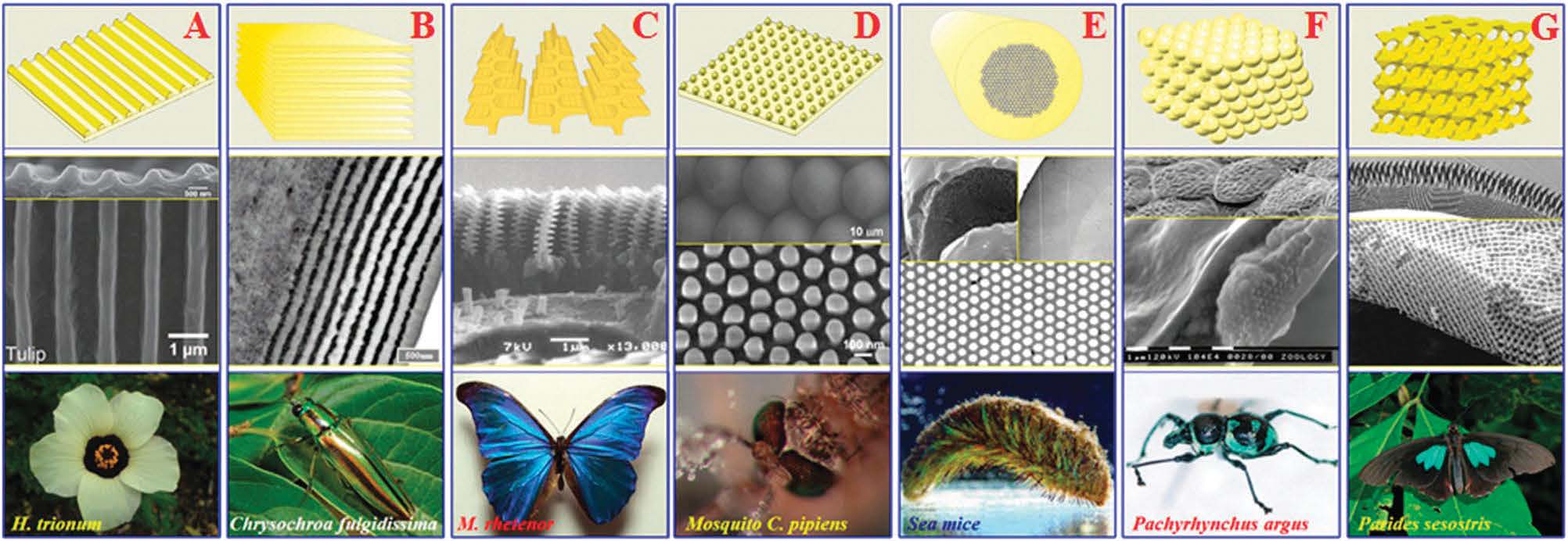
Examples of structural flowers in nature: A - trifoliate hibiscus (Hibiscus trionum); B - tamamusi beetle (Chrysochroa fulgidissima); C - butterfly of the species Morpho rhetenor; D - common mosquito (Culex pipiens); E - sea mouse (Aphrodita aculeata); F - beetle of the species Pachyrhynchus argus; G - butterfly of the species Parides sesostris
Structural color is the result of interference of light, which is scattered by nano-sized non-absorbing surface elements. It is a more physical process than a chemical one, as is the case with pigmentation, where color depends on selective absorption along the wavelength.
Structural colors have many advantages over pigment colors:
- , , ;
- ;
- , .
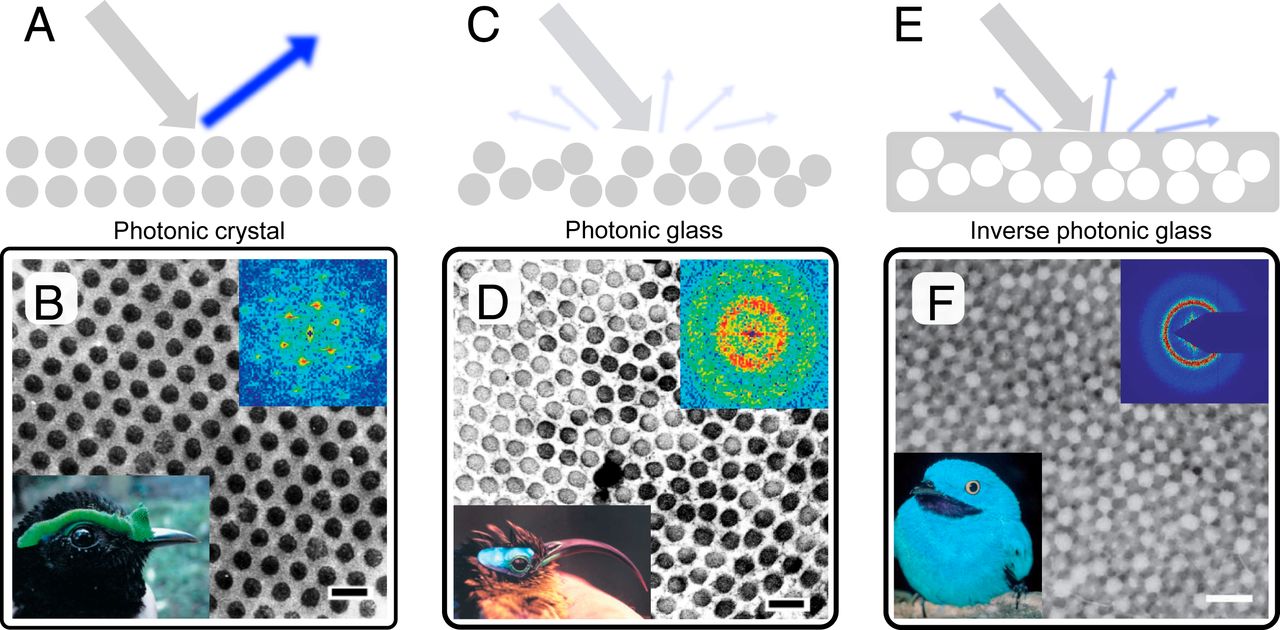
Image №1
Taking into account the positive properties of structural colors, many techniques have been developed for their recreation, or rather techniques for creating hierarchical structures or structures of short-range ordering with colors independent of the angle. The result of these developments is photonic glass (PG for photonic glass ), which has the biological equivalent of the plumage of many birds (pictured above).
The nuance is that in nature, structural colors are only blue shades. Reds and greens are usually achieved with long-range structures or pigmentation. Of course, there are techniques to create an artificial structural red hue. However, as the authors of this work claim, the optical properties of a material of this color are extremely poor.
The question arises - is it possible, in principle, to create a full-fledged structural red color? In order to answer this question, the scientists decided to use a numerical approach that provides direct access to the reflection spectrum of an arbitrary structure and allows the study of intermediate scattering modes, that is, between single scattering and diffusion behavior.
Research results
To begin with, using a numerical algorithm, variants of photonic glass (direct and inverse) with different scattering properties and structural correlation ( structure factor * ) were created.
Structural Factor * is a mathematical description of how a material scatters incident radiation.Next, the optical properties of the generated structures were calculated using the finite difference method in the time domain. The created model was deliberately limited to two-dimensional space, since such structures are most often found in nature (image above). Focusing on the two-dimensional structure also allows you to expand the range of studied parameters, while limiting computational costs. Nevertheless, scientists are confident that the results obtained can be applied to describe three-dimensional structures.
If there is no absorption, then scattering in the photonic glass occurs as a result of interaction between the characteristics of individual particles (size, shape, and refractive index) or due to the interaction between the properties of a group of particles (filling fraction and structural correlations).
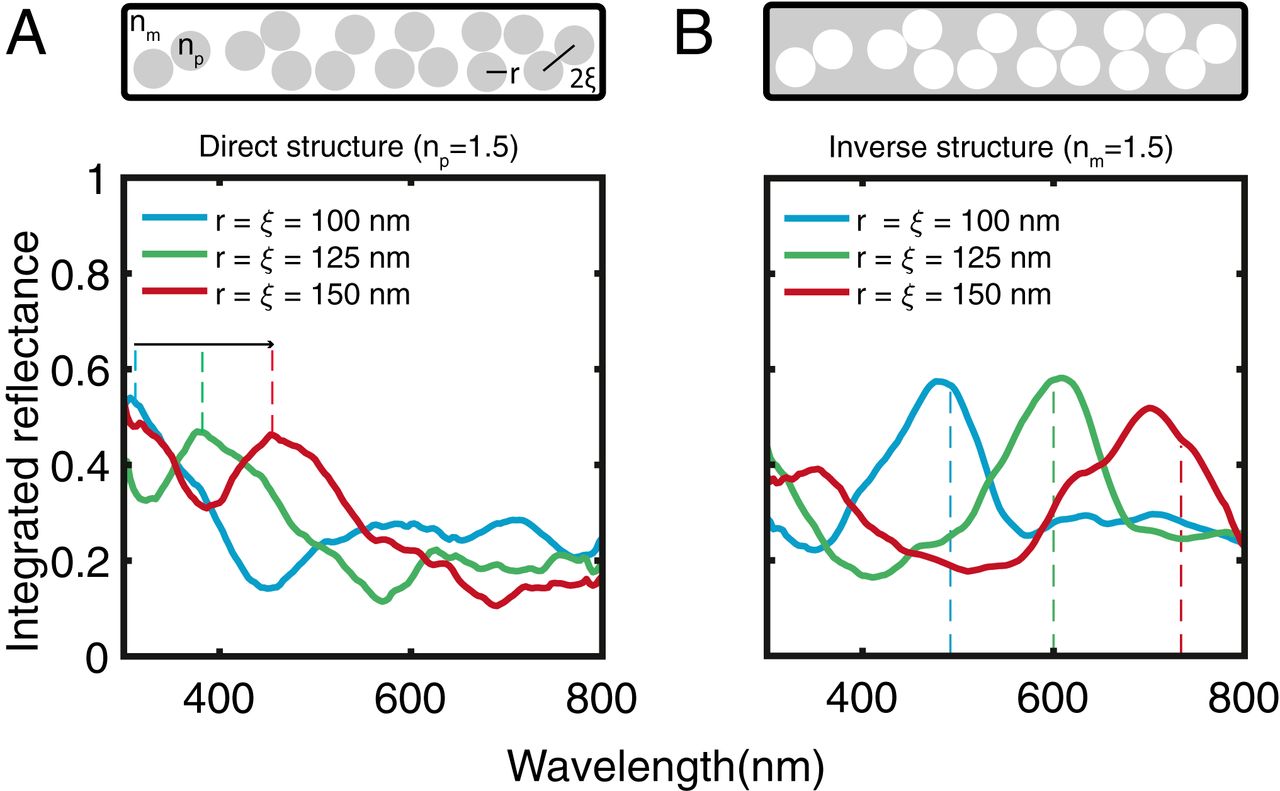
Image No. 2
In the case of direct PGs, the reflection is dominated by Mie * resonances determined by the properties of the scatterer ( 2A ). Thus, the reflected color can be changed to visible by resizing the diffuser.
Mie resonance * - an increase in the intensity of radiation scattered by a spherical particle for certain wavelengths comparable to the size of a particle (named after Gustav Mie, 1868-1957).However, as the particle size increases, the Mie resonance peak shifts to the red side, and a second peak appears in the blue part of the spectrum, which corresponds to a higher order resonance mode. But in the light scattering in inverse PGs, structural correlations ( 2B ) prevail . The reflection peak, the position of which is in good agreement with the predictions of Bragg's law * , is more pronounced than in direct structures.
Bragg diffraction * is the phenomenon of strong scattering of waves on a periodic array of scatterers at certain angles of incidence and wavelengths.The appearance of a single peak in the visible spectrum demonstrates that using inverse PGs is an effective strategy to minimize the form factor in the overall optical response of the system in favor of structural contributions.
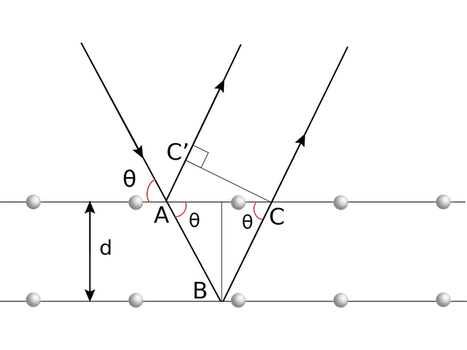
Bragg's law formula: nλ = 2d · sin θ, where d is the lattice period; θ is the angle of incidence of the wave; λ is the radiation wavelength; n is the number of waves.

Dependence of the isotropic structural color on the refractive index for direct (top) and inverse (bottom) PG, respectively.
Changing the refractive index affects the relationship between shape and structure contributions. Systems with a high refractive index are dominated by form factor resonances, which prevent them from achieving good color purity in the red region of the spectrum for both straight and inverse PGs. For direct systems, even when the refractive index contrast is low, form factor resonances result in enhanced reflections on the shortwave side of the structural peak. On the contrary, in the case of inverse PGs, it is seen that the structure factor forms a well-separated peak in the visible spectrum, even in the red region of wavelengths.
It follows from this that low refractive index inverse PGs may outperform straight PGs in terms of color purity and saturation.
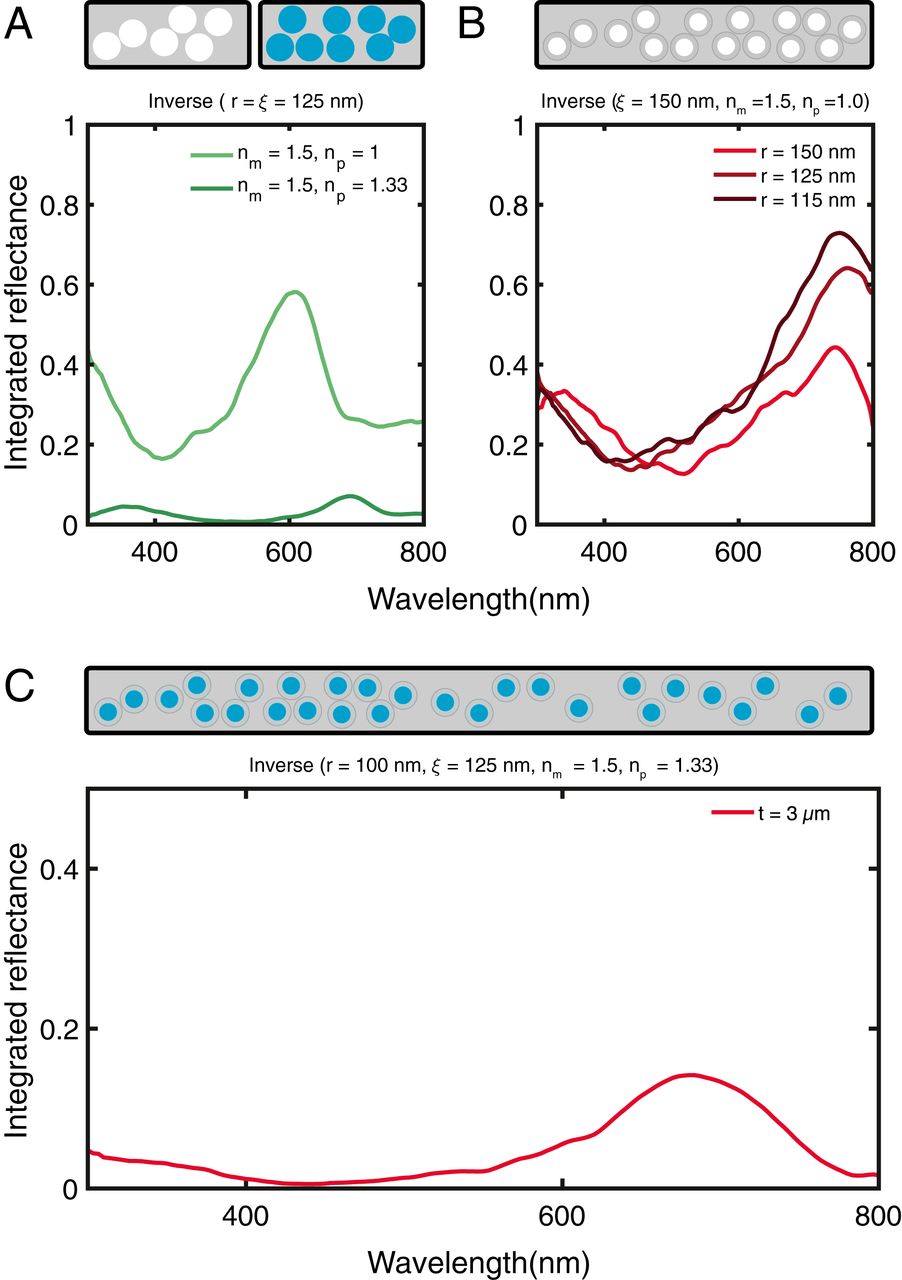
Image No. 3
A decrease in the contrast of the refractive index between the scattering matrix (n m ) and scattering centers (n p ) can further contribute to the structural contribution. Figure 3A shows that an increase in np leads to a broadband decrease in the reflection coefficient and a redshift of the structural peak. The structure peak decreases in width and has a higher intensity compared to its background, resulting in better color purity.
A decrease in the contrast of the refractive index reduces the role of multiple scattering, which in one way or another is present in disordered systems. This limits isotropic structural colors to the light propagation mode between diffuse scattering * and ballistic transfer * .
Diffuse scattering * - scattering resulting from any deviation of the material structure from the structure of a perfectly regular lattice.
Ballistic transfer * is an unhindered flow of charge carriers (usually electrons) or energy-carrying particles over relatively large distances in a material.Multiple scattering becomes predominant with increasing sample thickness, resulting in broadband unsaturated response.
The corresponding observations can also be applied to scatterers with complex geometries. As the scientists clarify, their previous work presented the idea of using core-shell * particles to separate the contributions of the form factor and the structure factor and achieve a separate peak in the long-wavelength region of the spectrum.
-* — , , .Figure 3B shows that decreasing the size of the scattering center (core) while maintaining the structural correlation length increases the intensity and width of the long-wavelength (structural) peak. At the same time, the short-wavelength contribution of the Mie resonances is shifted towards the ultraviolet.
In 3A it is shown that lower refractive index contrast can suppress multiple scattering, while the contributions form the separation factor and the structural factor is possible through core-shell particles ( 3B ).
The combination of both methods is shown in 3C . This allows for higher values of purity and color saturation due to well-separated peaks in the long-wave part of the visible spectrum.
At the next stage of the study, scientists paid attention to assessing the saturation and purity of the color. To quantify these parameters, the reflectance spectra of direct, inverse PG and shell nuclei were converted to color shades. Color purity can be defined as the normalized distance from the white point on the chromaticity diagram with respect to the red point (in the case of red colors). Saturation quantifies how much the intensity of reflected light is spread across a spectrum at different wavelengths.

Image # 4
On 4A, the various systems for the shades of red are plotted on the CIE XYZ color space diagram. At 4B, the corresponding values for purity and saturation are calculated.
It is worth noting that all inverse PGs exhibit higher color purity and saturation values than the reds of straight PGs. However, the inclusion of core-shell particles in the particle system does not result in significant improvement over standard inverse PG. If you combine both approaches, you can get higher levels of purity and saturation. Nevertheless, they will be much lower than that of real red (i.e., from the KZS model - red, green, blue).
For a more detailed acquaintance with the nuances of the study, I recommend that you look into the report of scientists and additional materials to it.
Epilogue
In this work, scientists were able to demonstrate that photonic glasses have internal limitations in achieving saturated red hues. This is due to the interaction between the resonance associated with the structure factor, the scattering associated with the form factor, and the multiple scattering background. A foundation like this makes it easy to achieve structural color in the UV-blue range, but not at longer wavelengths.
It has also been proven that high purity and color saturation for reds cannot be achieved in isotropic short range ordering structures, even in the case of complex diffuser morphologies.
According to scientists, such observations may indicate that nature was forced (figuratively speaking) to create alternative ways of forming red shades (for example, multilayer or diamond structures).
Combining several approaches to create a structural red hue can improve clarity and saturation, but they are still not enough to achieve real red.
It has also been found that, due to the complex interaction between single and multiple scattering, yellow and orange, in addition to red, are also difficult to obtain in terms of structural colors.
Such research allows a better understanding of structural colors, as well as to develop new methods for creating materials that can be the basis for those shades that are not found in natural structural colors. New types of nanostructures (for example, network or multilayer hierarchical structures) can help in this, according to the authors of the study.
Be that as it may, work on structural colors will continue in the future. Modern methods of studying nanoscale structures and means of their reconstruction allow a more detailed description of the processes occurring in the material, which, naturally, contributes to the achievement of control over these processes.
Thanks for your attention, stay curious and have a good work week, guys. :)
A bit of advertising
Thank you for staying with us. Do you like our articles? Want to see more interesting content? Support us by placing an order or recommending to friends, cloud VPS for developers from $ 4.99 , a unique analogue of entry-level servers that we have invented for you: The Whole Truth About VPS (KVM) E5-2697 v3 (6 Cores) 10GB DDR4 480GB SSD 1Gbps from $ 19 or how to divide the server correctly? (options available with RAID1 and RAID10, up to 24 cores and up to 40GB DDR4).
Is Dell R730xd 2x cheaper in Equinix Tier IV data center in Amsterdam? Only we have 2 x Intel TetraDeca-Core Xeon 2x E5-2697v3 2.6GHz 14C 64GB DDR4 4x960GB SSD 1Gbps 100 TV from $ 199 in the Netherlands!Dell R420 - 2x E5-2430 2.2Ghz 6C 128GB DDR3 2x960GB SSD 1Gbps 100TB - From $ 99! Read about How to build the infrastructure of bldg. class with Dell R730xd E5-2650 v4 servers at a cost of 9000 euros for a penny?